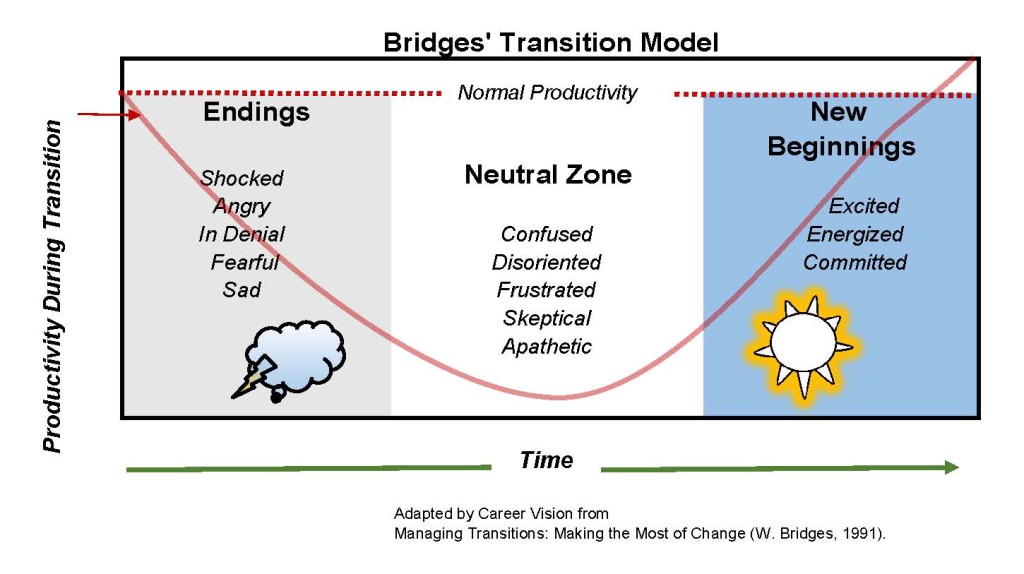Transitions: Weathering the Rough Storms of Change
Mark Twain is credited with saying, “If you don’t like the weather in New England now, just wait a few minutes.” But, no matter what region of the country you hail from, you’ve probably made a similar reference about the local forecast. After all, weather conditions change all the time. You’ve learned to adapt to the change by throwing on a sweater when you’re feeling a bit chilly. That’s simple enough.
But, unfortunately, many changes we experience in life are not as easy to deal with. When facing big transitions, many people feel uncomfortable. For example, if you’re anticipating a major transition in your personal life, graduating college and starting your first job, or transitioning from high school to college, you’re probably a little apprehensive. And that’s normal, especially when you don’t know what to expect. So, to embrace change (or at least accept it), you need to understand it first.
Change versus Transition
The challenges people experience with change are generally not because of the change itself but rather the resulting transitions. William Bridges, organizational consultant and author of several books on this topic, says that the distinction between change and transition is very minor yet extremely important.
- Change is external. It’s something that happens to you even if you don’t agree with it. Change can happen very quickly (like when the weather changes from one hour to the next).
- Transition is internal. It’s what happens inside of your mind when you face change. Transitions happen slowly over time (like the passing from one season to another).
Bridges’ Transition Model
According to Bridges, people transition through change in three distinct stages: Ending, The Neutral Zone, and The New Beginning. Each of us goes through these stages at our own pace. People who are comfortable with change, for instance, may move ahead to the new beginning stage faster than others. The relative significance of the change also impacts the time needed to move from one stage to the next.
The Transition Model below shows the commonly-held feelings during each stage. Think of Bridges’ model as a sort of weather map, helping you navigate the storms of change while looking forward to brighter horizons. Using this model, you can gain insight into your own experiences with transitions and get a better sense of what to expect as you face change (whether in your personal, professional or academic life).

Here’s a closer look at each of these stages:
-
Stage 1: Ending, Losing & Letting Go
The ending stage is about losing what you had in the past. When changes occur, it’s normal to experience some emotional upheaval because you must let go of something you were comfortable with. It’s kind of like the changing seasons. If autumn is your favorite time of year, you may feel a bit sad when that last, lone leaf has fallen from the trees.
This stage is typically marked with resistance. You fight change because you want to hold on to the way things used to be. Common feelings include shock, denial, fear, anger and sadness.
The ending stage sometimes goes unnoticed, especially when the change is viewed positively. Yet, even when change is good, something must be left behind or replaced. Therefore, as uncomfortable as this stage can be, it simply cannot be ignored or avoided. After all, you can’t embrace the new beginning until you acknowledge and accept that something is ending. As Bridges puts it, “We come to beginnings only at the end.”
-
Stage 2: The Neutral Zone
In this stage, you’re smack dab between the old and the new. You may still feel attached to the way things were; and, at the same time, you’re adapting to the changes. It’s like that awkward time in between seasons. The calendar tells you that fall has arrived. But you’re keeping some summer clothes in your closet…just in case!
So the neutral zone throws you off balance. As noted author Marilyn Ferguson says, “It’s not so much that we’re afraid of change or so in love with the old ways, but it’s that place in between that we fear. It’s like being between trapezes. It’s Linus when his blanket is in the dryer. There’s nothing to hold on to.”
You may feel confused and disoriented. You may become frustrated, finding it hard to establish goals and predict the outcomes of your efforts during this in-between stage. You may find it difficult to remain as focused, engaged, and productive as you used to be. This is especially true if the changes require you to gain additional knowledge and skills, or navigate new processes, procedures, and systems.
-
Stage 3: The New Beginning
The final stage of transition is marked by acceptance and engagement. With a better sense of direction, you’re gaining back a sense of self-control and confidence, as you adjust to the changing situation or circumstances.
Much like the springtime, this is a time of renewal, new beginnings and growth. It’s here that you begin to embrace the changes. You’re energized and excited to see the positive impacts of your efforts and you feel a new sense of commitment.
There Can Be No Spring without Winter
As you weather the storms of change, remember that transition is the “natural process of disorientation and reorientation that marks the turning points in the path of growth” (Bridges). Just as there can be no spring without winter, it’s only through change that you grow.